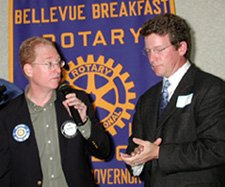|
|

Kim Shrader introduces speaker Colin Moseley at Friday’s meeting.
|
Colin Moseley, Chairman of Simpson Investment Company, is a fifth generation member of his family to run this highly successful Northwest company. Colin’s topic was Certification and Sustainable Forestry. As the manager of a private forest products company and father of four, he is encouraged to know there is positive news in the forest products industry. “Through a program of certification, we are able to achieve goals of sustainable forestry, while we protect soils, wildlife, and water quality.”
Moseley took a walk back in time, showing patterns of growth from history. “Some 12,000 years ago, there were no trees in the Seattle area because of the effects of the Ice Age. Volcanoes, floods, and fires were major factors in a changing landscape. Fire is major factor that shapes our forests. A history lesson: it's not nature’s way to remain the same.”
Early pioneers in 19th century began to harvest timber for commercial use. Wind, landslides, and floods, along with fire, continued to bear heavily on the development of forests. “Another lesson is that nature likes variety. Old growth forests have been decreased dramatically through the various passages of time by nature’s handiwork.”
Saul Simpson came looking for gold in the mid-1800’s. He was Colin’s great grandfather. Saul founded Simpson in 1890 in Shelton. “His was a ‘cut & run’ operation, where the trees were taken with no thought to restoring the land. However, as time moved on, Saul worked the land, then held on to it. It became a practice of the Simpson company in the 1930's to hold on to cut-over timber land. We began caring for the land and the trees.”
The idea of sustainable forestry has been embraced over the past 50 years. Certification of accepted land use is part of how timber companies work today. This has been brought about by changing environmental laws and regulations. The program certifies the stewardship of operations. These are all voluntary programs, developed by the American Forest & Paper Association. Currently, the program encompasses a 100 million acres in North America – about 90% of what's available in private hands coming under this program.
The Program oversees what the company does to responsibly manage forest property. Three-quarters of private timberland has undergone this review by third-party organizations. Once a company has passed the review process, they become part of the “Sustainable Forestry Initiative.” A logo has been developed to recognize those companies who have gone through third-party audits.
While the industry has made great strides, environmental groups want more. Clear cutting – the most unsightly thing about forestry – according to some is Illegal by today's forest practice rules. The lesson learned is that forests are incredibly vibrant and able to develop their own standards.
The Sustainable Forestry Initiative goes beyond forest practice rules now in place and touches many aspects of logging activities. Adding culverts to prevent erosion is a major technique, and timber areas are replanted within three years after harvest according to State law. The Initiative requires replanting in two years, while it’s a fact that many companies replant in just one year. Clear cutting is allowed, but under new limits.
Newly planted trees have better chance to grow from clear-cutting. More sunlight reaches the trees, making better stands. An example would be Mt. St. Helens. The eruption of the mountain changed the face of the forest. The blast cut a wide swath through Southwest Washington, affecting 45,000 Weyerhaeuser acres. This was replanted in 1981, and a great recovery has occurred in only 20 years.
Man's hand has brought about rapid recovery. Public land is being allowed to recover on its own and Moseley said “it will take decades to catch up with private replanted land in the Mt. St Helen’s area.
The technique of selected harvesting works in stands of mixed species as well as different aged trees. This works particularly well on the eastside of the Cascades. Select harvesting needs more roads to accomplish.
Certification will become more broadly used across the world, Moseley declared. “The constancy of change brings a variety of patterns across the landscape. Trees are a renewable resource. Market pressure brings about change and the new certification process is dedicated to practicing sustainable forestry. There are more forests and more trees than there were 100 years ago because we’re stewards of the land and what it produces.” Colin asked for support of his industry’s efforts to help make a better world. Thanks to Bob Holert for his introduction.
|